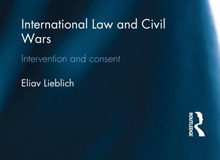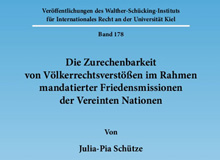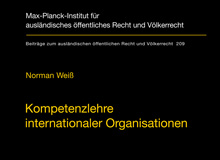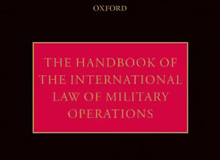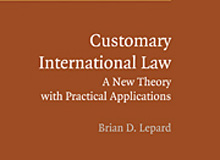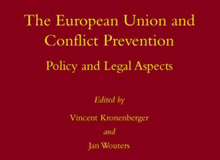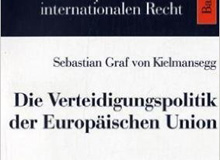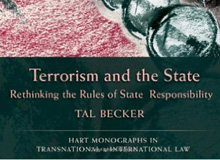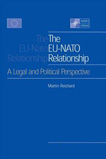
Martin Reichard, The EU–NATO Relationship: A Legal and Political Perspective. Aldershot: Ashgate Publishing, 2006. 428 pages. ISBN 0-7546-4759-5. GBP 65.
The process of Western European integration after the Second World War was characterised by an institutional and substantive division of labour. During the Cold War years, NATO provided the principal forum for cooperation in military and defence matters, the European Economic Community served as a framework for economic union, while from the 1970s onwards European Political Cooperation offered its participant a venue for coordinating their national foreign policy positions. The end of the Cold War has brought about a gradual convergence of these previously separate tracks of integration. The creation of the EU with its Common Foreign and Security Policy (CFSP) in 1993 brought under one roof the economic and the foreign policy track, and opened the way for the development of a common defence policy. This policy became a reality in 1999, when the European Council launched the European Security and Defence Policy (ESDP) in order to provide the Union with the necessary military and civilian capabilities to assume a stronger role in international crisis management. As a result of these developments, the EU now for the first time combines the military, the economic, and the foreign policy track of European integration within a single legal and institutional framework.
The emergence of the EU as an independent actor in civilian and military crisis management has important repercussions for other organizations active in this field, in particular for NATO. Not only do the respective security functions of the EU and NATO overlap to a considerable extent, but the Union lacks sufficient military planning and command capabilities of its own and will therefore for the foreseeable future have to rely on NATO’s collective assets to conduct certain types of operations. The launch of the ESDP has thus created new opportunities for cooperation and for competition between the two organizations.
The objective of the book by Martin Reichard is to examine the most important aspects of the relationship between the EU and NATO following the launch of ESDP. The first three chapters begin by placing the EU–NATO relationship within its broader political and strategic context. Chapter 1 offers an overview of the current state of the transatlantic relationship in the aftermath of the September 11 attacks and the war in Iraq. While a transatlantic divorce is still possible, Reichard considers that for now the United States and Europe remain strategic partners by default, even though a more assertive Europe coupled with disagreements over policy means that the balance of transatlantic relations is shifting. Chapter 2 traces the development of the ESDP, describing its political origins, legal basis and institutional framework. Particular attention is devoted to the controversy surrounding the question of whether or not the EU should acquire its own strategic planning and command capabilities in the form of an independent EU headquarters separate from NATO. Reichard examines in detail the compromise reached by the Member States in this matter in late 2003, whereby EU-led crisis management operations may rely either on NATO’s collective planning and command assets, on national or multinational assets made available by the Member States, or in certain circumstances on the Civilian/Military Cell established within the EU Military Staff, a military body forming part of the Council of the EU. Chapter 3 completes the picture by explaining how NATO responded to the end of the Cold War by transforming itself from an organization geared towards territorial self-defence to one specializing in robust peace support operations in Europe and, following September 11, worldwide.
The remaining part of the book deals with specific aspects of the EU–NATO relationship. Chapter 4 describes the institutional framework for cooperation between the two organizations, focusing on the permanent arrangements for consultation and cooperation adopted by them in 2001. Chapter 5 considers the question of NATO’s primacy in European crisis management, that is whether or not NATO enjoys a right to decide to conduct a particular operation of its own or leave it to the EU to do so (known as the ‘right of first refusal’). Following an analysis of the relevant legal instruments and policy statements, Reichard comes to the conclusion that NATO does not enjoy a right to this effect under international law. Chapter 6 describes in considerable detail the nature and scope of the mutual defence obligations laid down in the North Atlantic Treaty and the Treaty Establishing a Constitution for Europe and explains, perhaps somewhat briefly, the interaction between these two regimes. Chapter 7 falls into two parts: the first offers and account of the steps taken by the EU and NATO to improve their military rapid reaction capabilities and considers the compatibility of their respective efforts, while the second part examines the cooperation between the two organizations in recent military crisis management operations, finding that in practice NATO’s primacy has not been at issue between them. The final two chapters deal with two specific legal problems singled out for their complexity. Chapter 8 analyzes the so-called Berlin Plus Agreement of December 2002 whereby NATO has granted the EU assured access to its strategic planning capabilities and agreed to make available, in principle, certain command assets for EU-led crisis management operations. Finally, Chapter 9 examines the rules adopted by NATO and the EU to guarantee the security of sensitive information, and considers to what extent these are compatible with the principles of transparency and proportionality.
The book’s central message is that responsibility for European security is gradually shifting from NATO to the EU. The respective security functions of the EU and NATO have been converging since the end of the Cold War. However, the launch of the ESDP has fundamentally altered the division of labour between the two organizations, since it has provided the EU with an independent operational capability and thereby enabled it take responsibility from NATO for conducting peace support operations in Europe and to match NATO’s efforts in other conflict zones, such as the one in Darfur. Moreover, the introduction of a mutual defence guarantee in the Constitutional Treaty means that NATO may be loosing its dominant position in the area of collective self-defence as well. Reichard has supplied ample evidence in support of this argument, yet the objective of the book, which is to examine selected aspects of the EU–NATO relationship, sits somewhat awkwardly with his thesis. For instance, the final chapter concerning the security of information does little to advance his central argument, though the exchange of classified information undoubtedly forms part of EU–NATO relations. As a result, the book at times reads more like a collection of essays than as a coherent whole.
In a courageous move, Reichard has decided to approach the subject matter from the perspective of both international law and political science in order to present a more complete picture of the EU–NATO relationship. For the most part, this interdisciplinary approach works quite well, bearing in mind that, as the author himself points out, relations between the EU and NATO are neither exclusively legal nor exclusively political in nature. Nevertheless, sometimes it is not evident whether the reader is faced with a legal analysis or a political assessment. Lawyers in particular (and not only those of the Kelsenian persuasion) may find that this interdisciplinary perspective has occasionally contributed to a less rigorous legal analysis. For example, Reichard suggests that the inclusion of a mutual defence clause in the Constitutional Treaty replaces a similar clause found in the Modified Brussels Treaty of 1954. This argument is unconvincing because, amongst other things, the termination of the Brussels Treaty is governed by the express terms of the Treaty itself, which Reichard fails to consider. Similarly, his analysis of the legal nature of certain arrangements signed by the High Representative for the CFSP in the context of the ESDP is led astray by the mistaken belief that Article 24 of the Treaty on European Union prevents the Council from authorizing the High Representative to sign international agreements on its behalf. Most bizarrely, however, Reichard attempts to interpret the Berlin Plus Agreement without having access to the actual text of the Agreement, which is classified. Instead, he relies on a joint EU–NATO press release and other related documents. While these documents offer valuable clues as to what the Berlin Plus Agreement involves, interpreting the terms of a press release simply does not constitute an alternative for interpreting the actual provisions of the Agreement.
Notwithstanding these reservations, Reichard’s work constitutes an important contribution to the study of the ESDP and of the European security architecture more generally. The book is well-written and relies not only on the existing academic literature, but also on a wealth of other sources, including policy statements and official documents. It offers an excellent overview of the political and strategic context of the EU–NATO relationship as well as valuable in depth studies of selected legal problems, such as the question of NATO’s primacy in military crisis management. As such, it deserves to be widely read both by international relations specialists and by international lawyers.
Published in (2007) 44 Common Market Law Review 1540–1542


